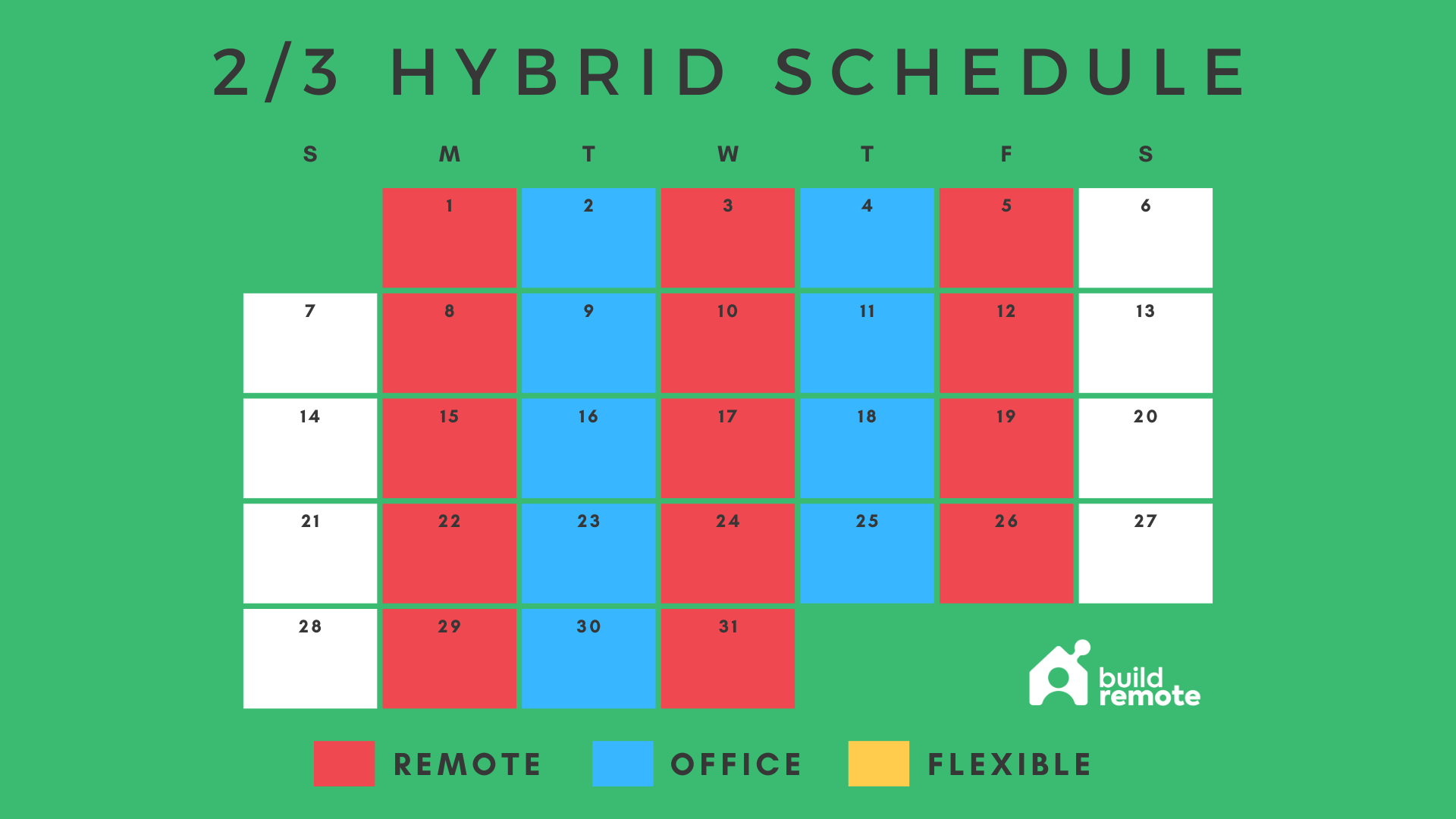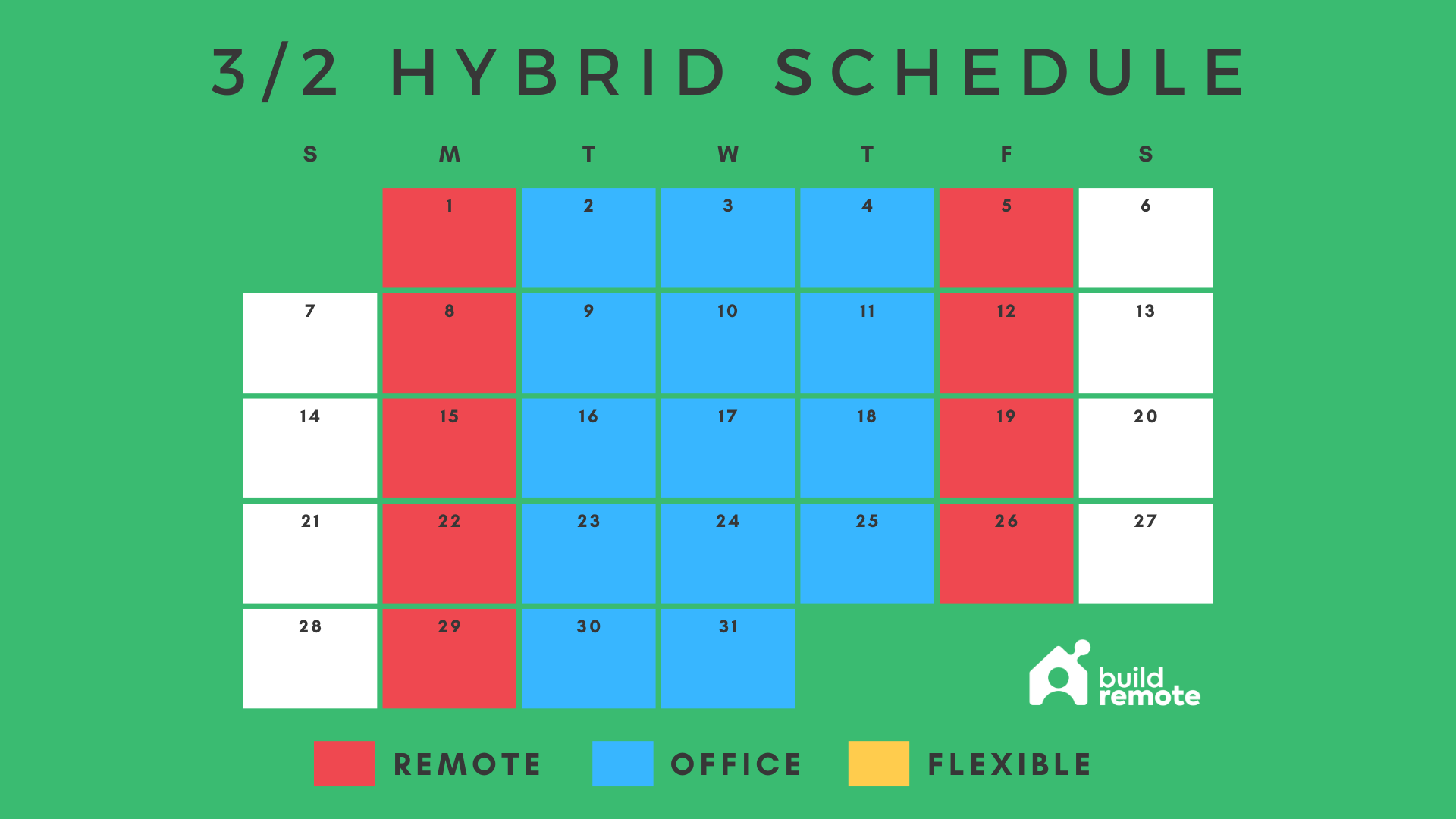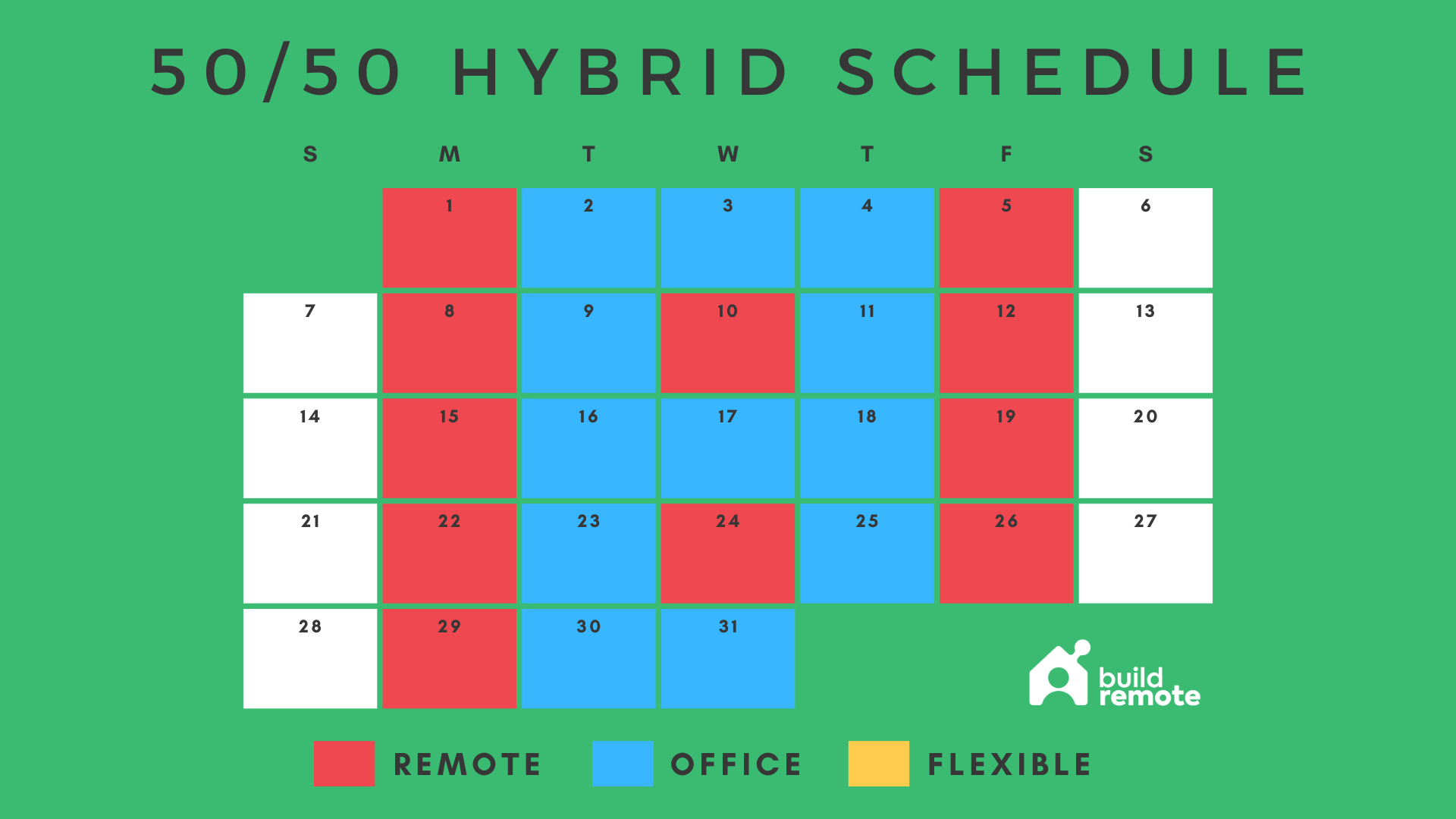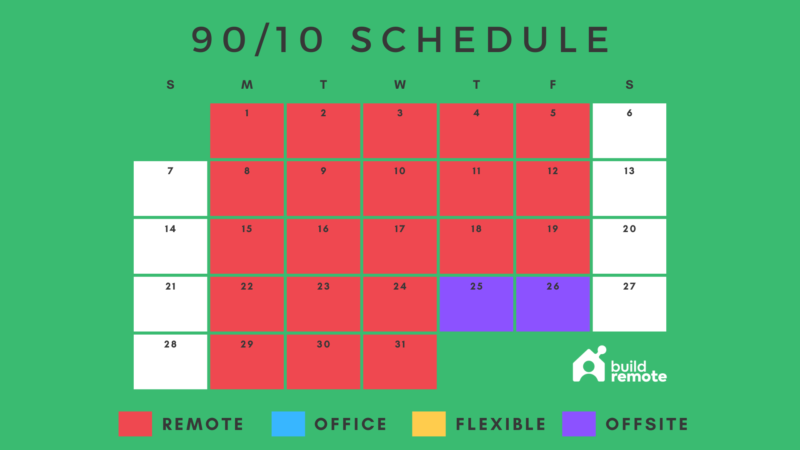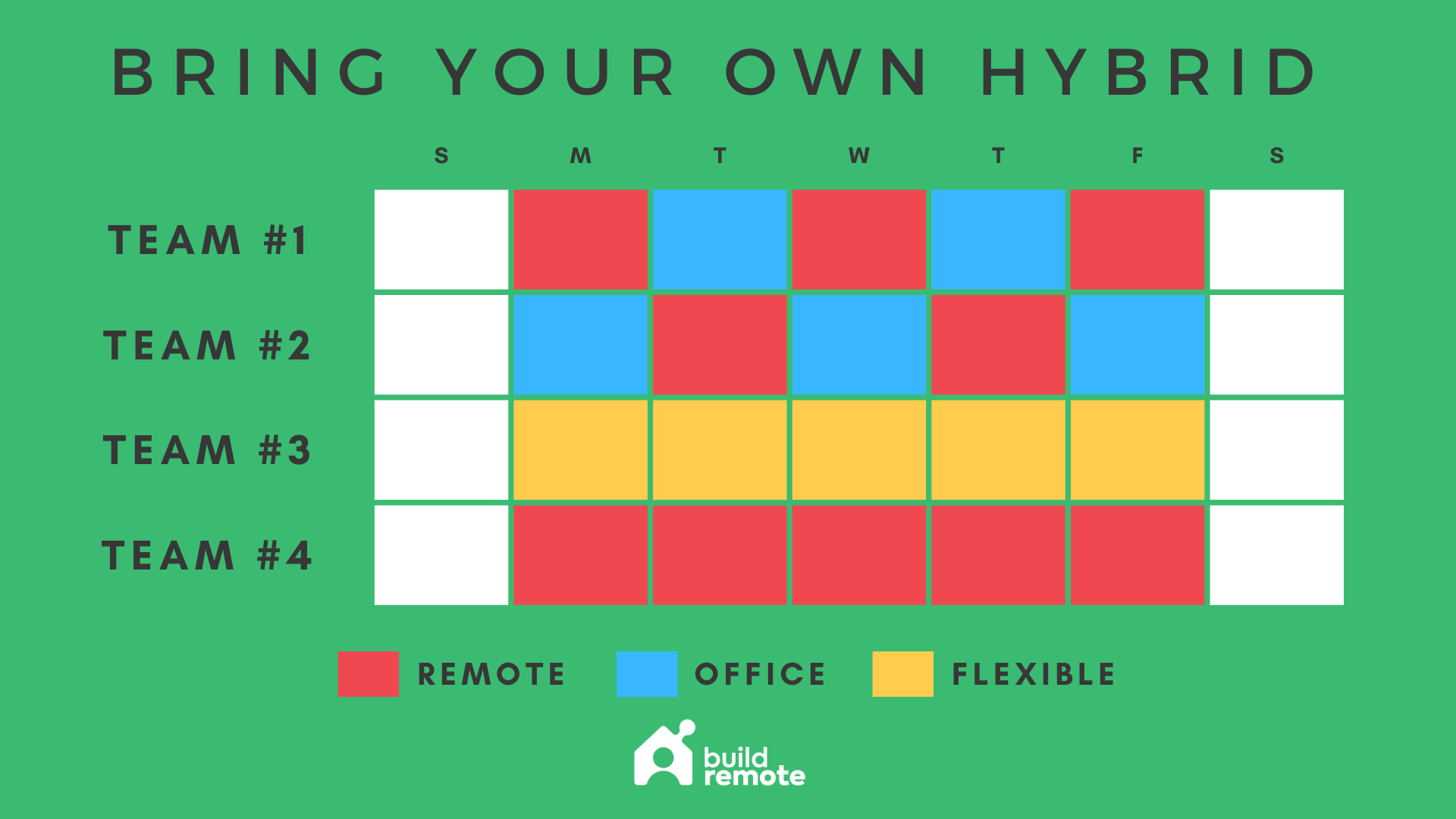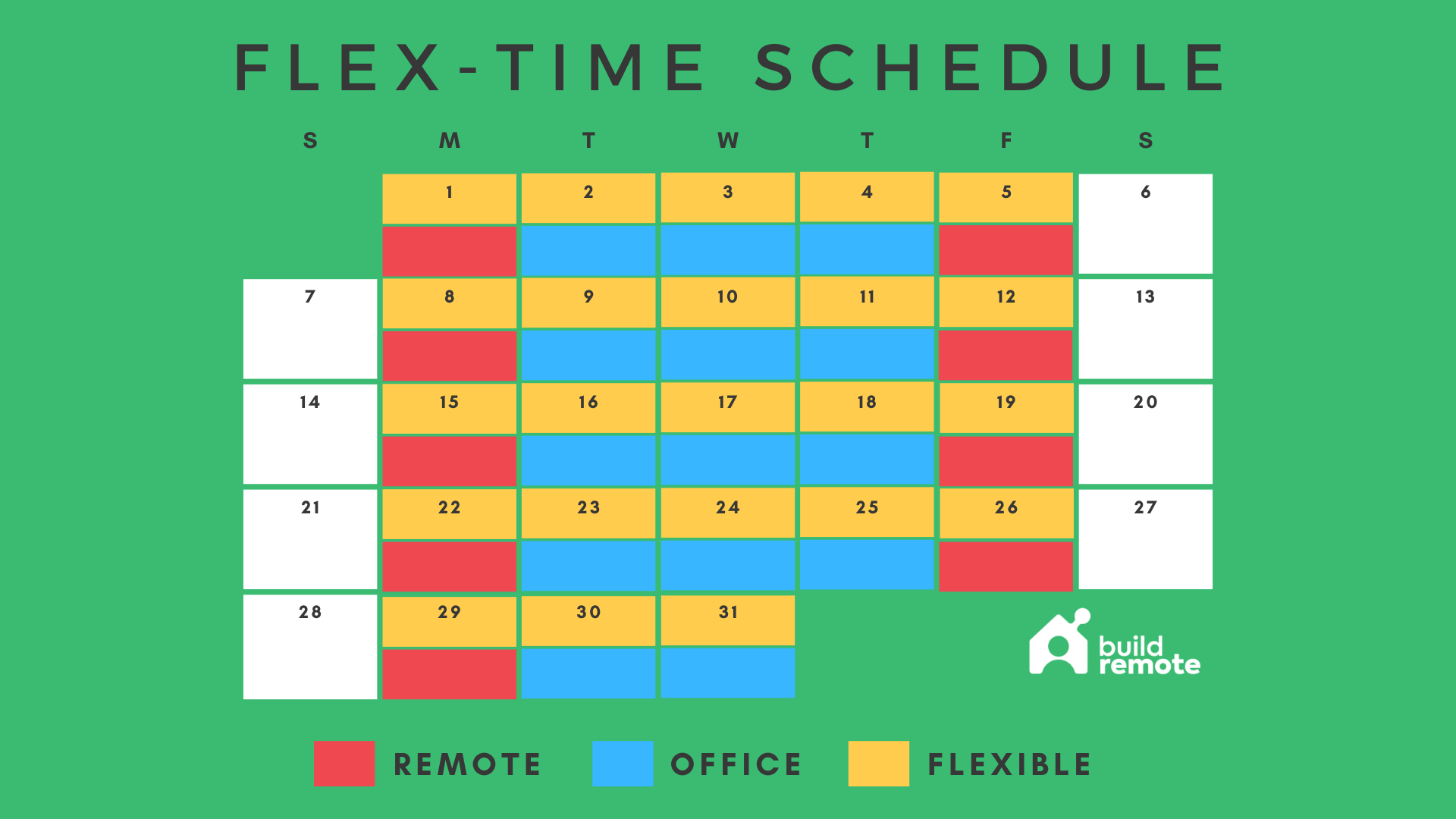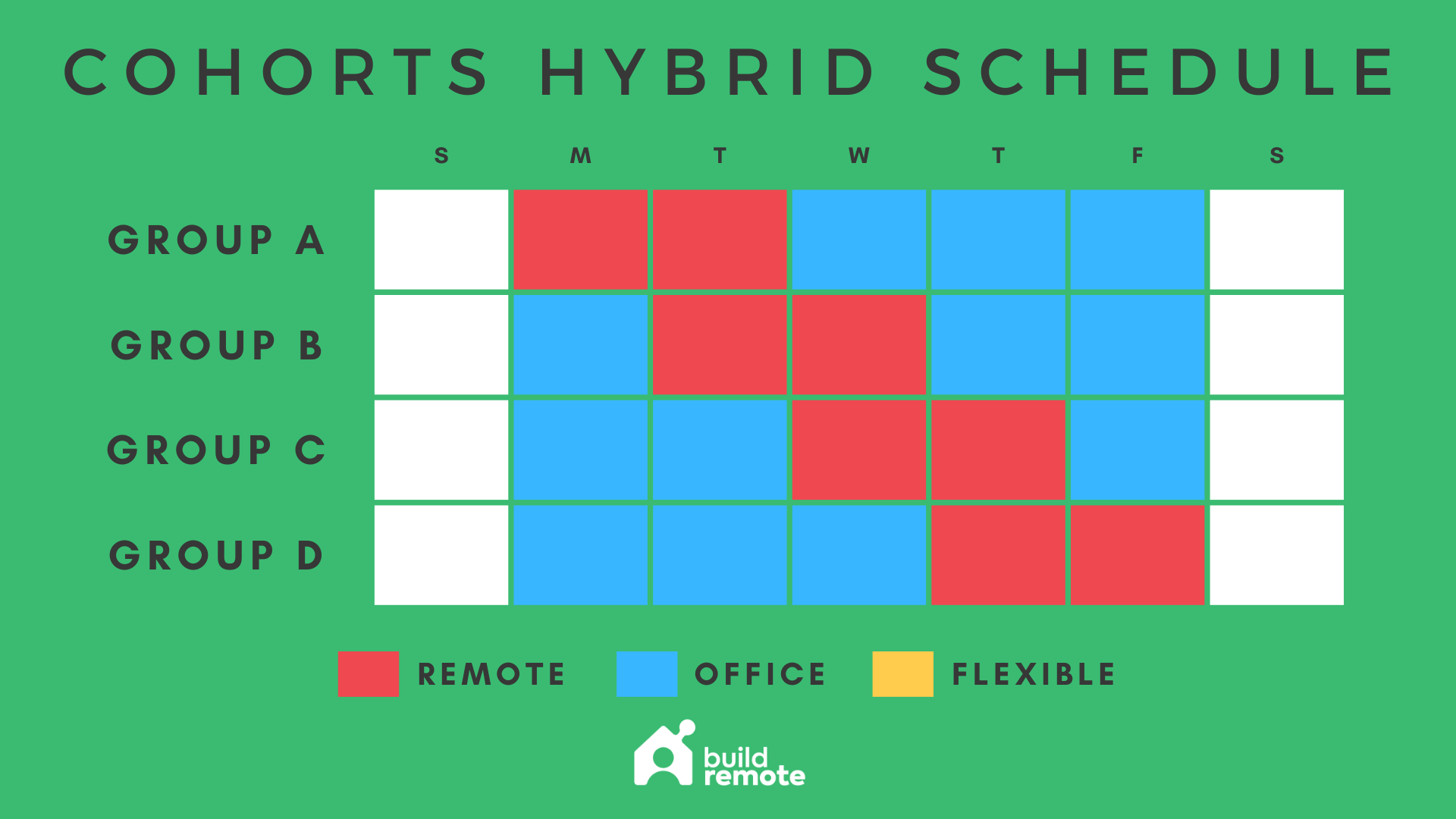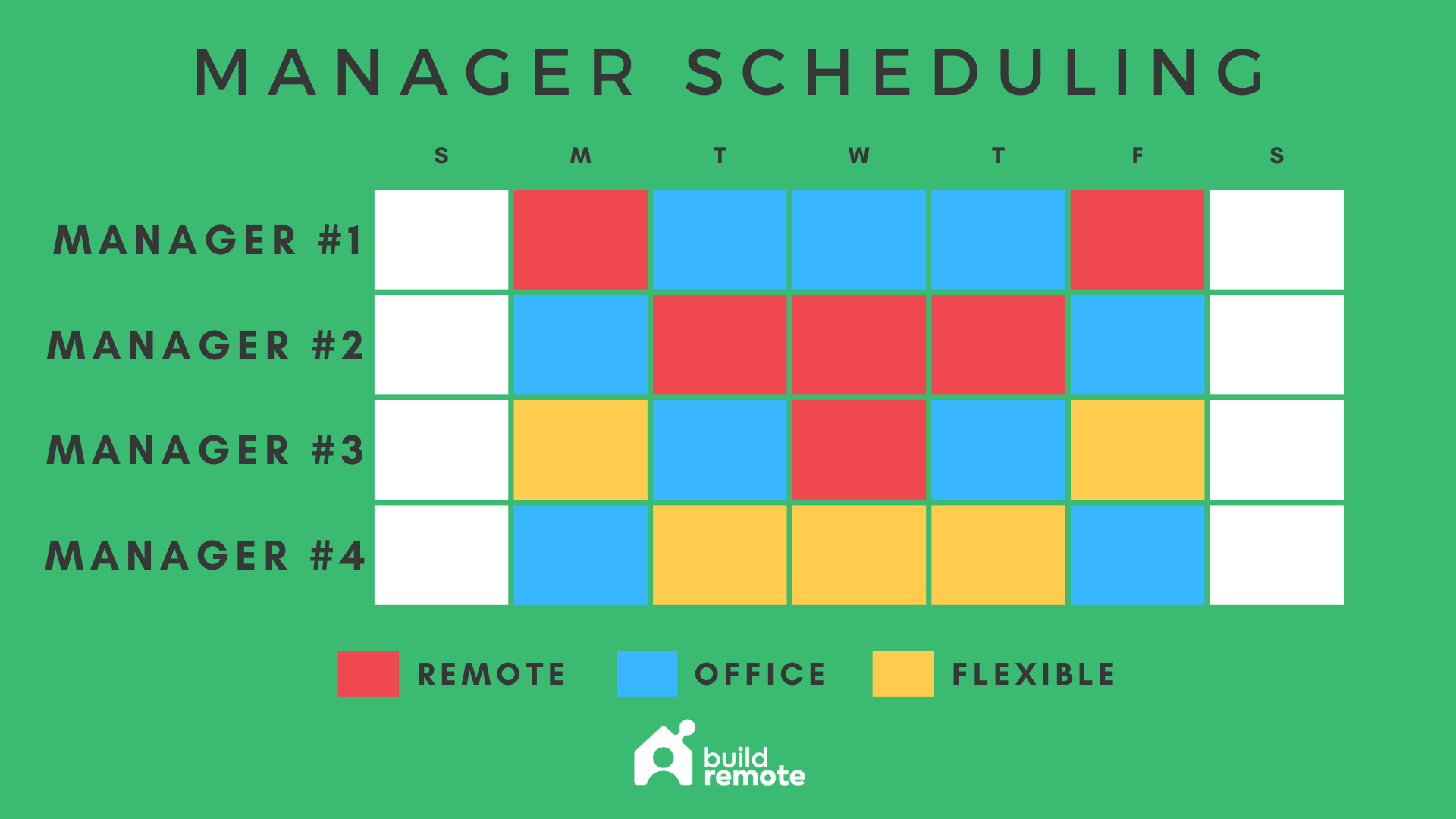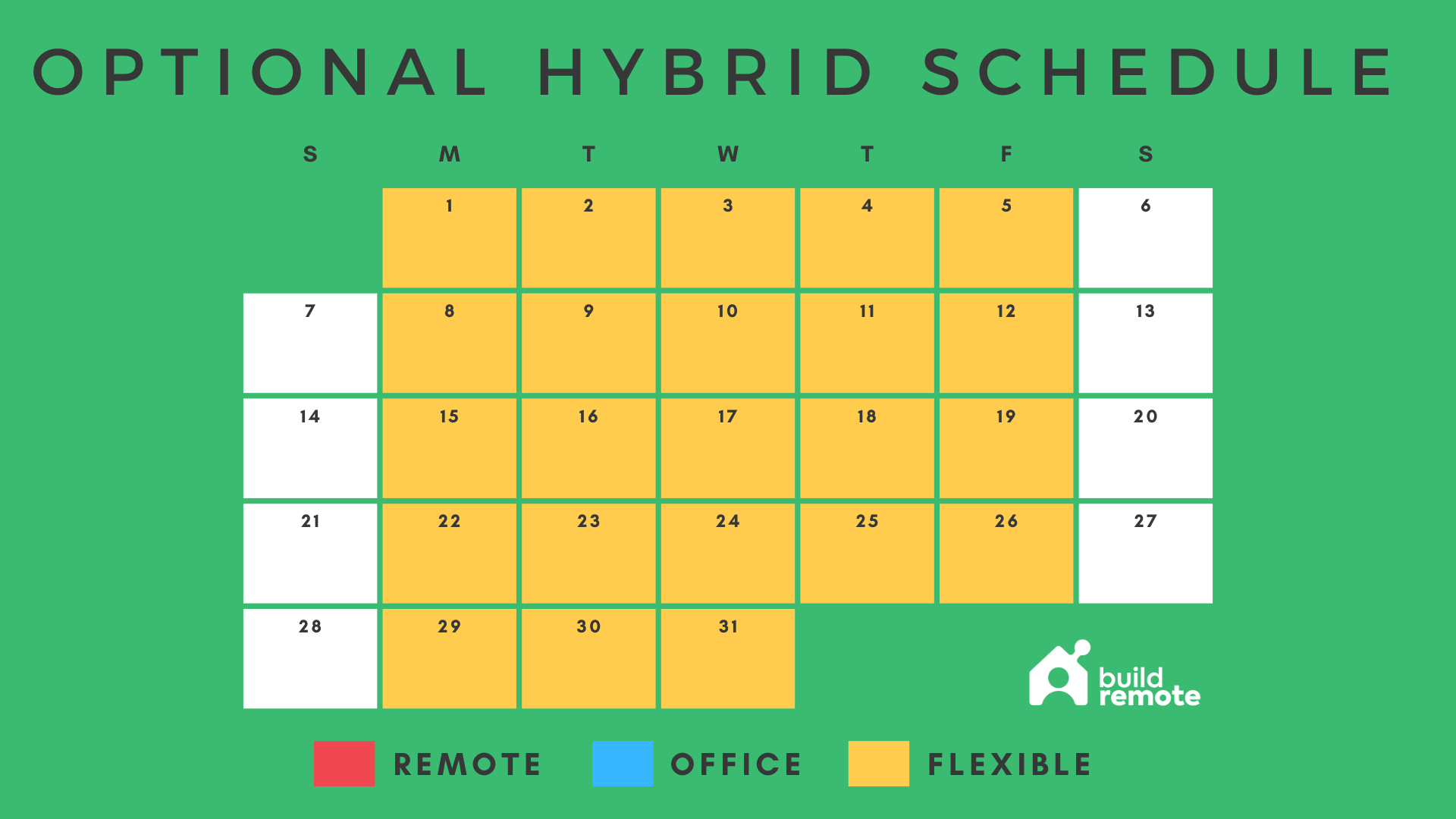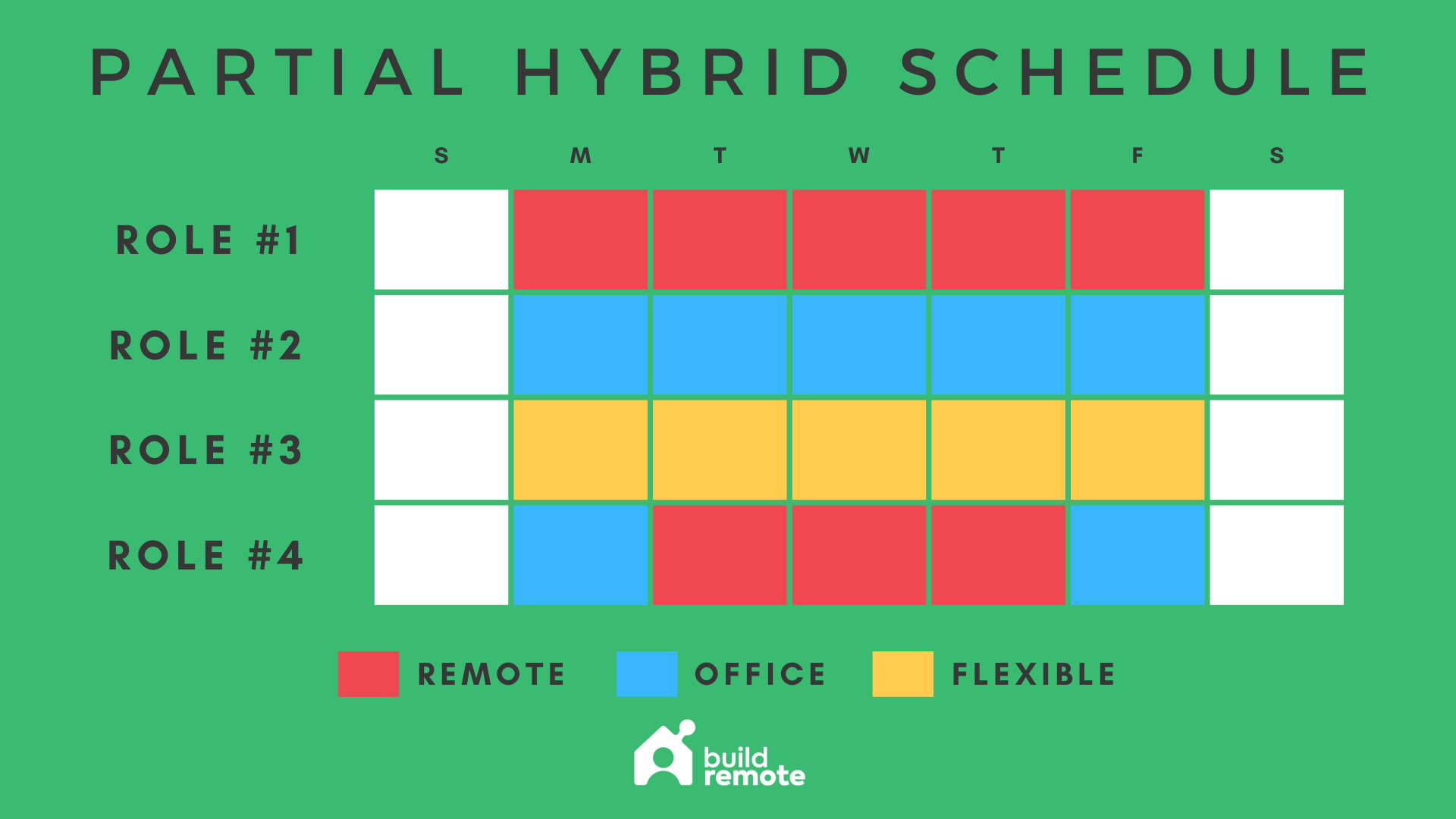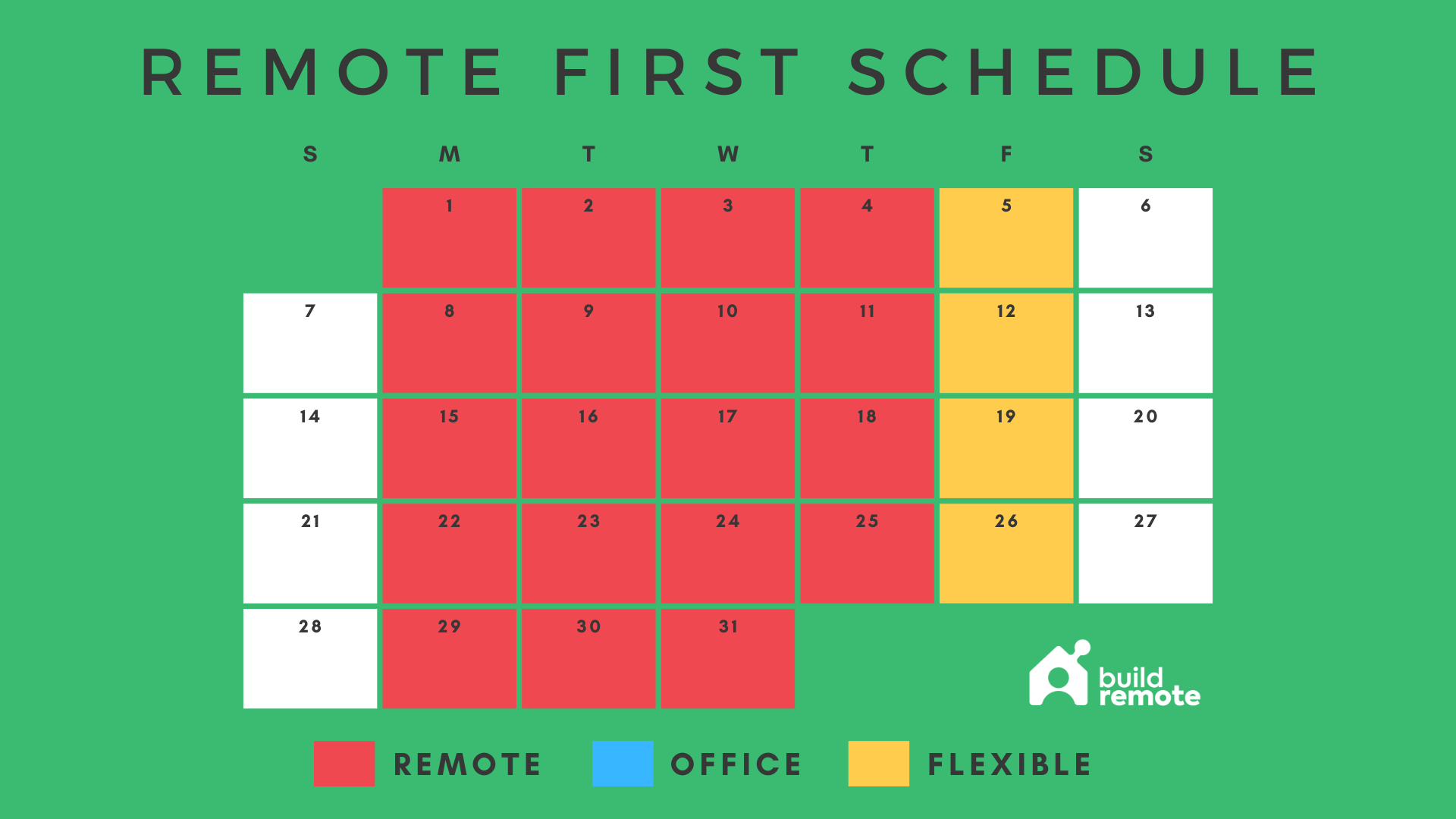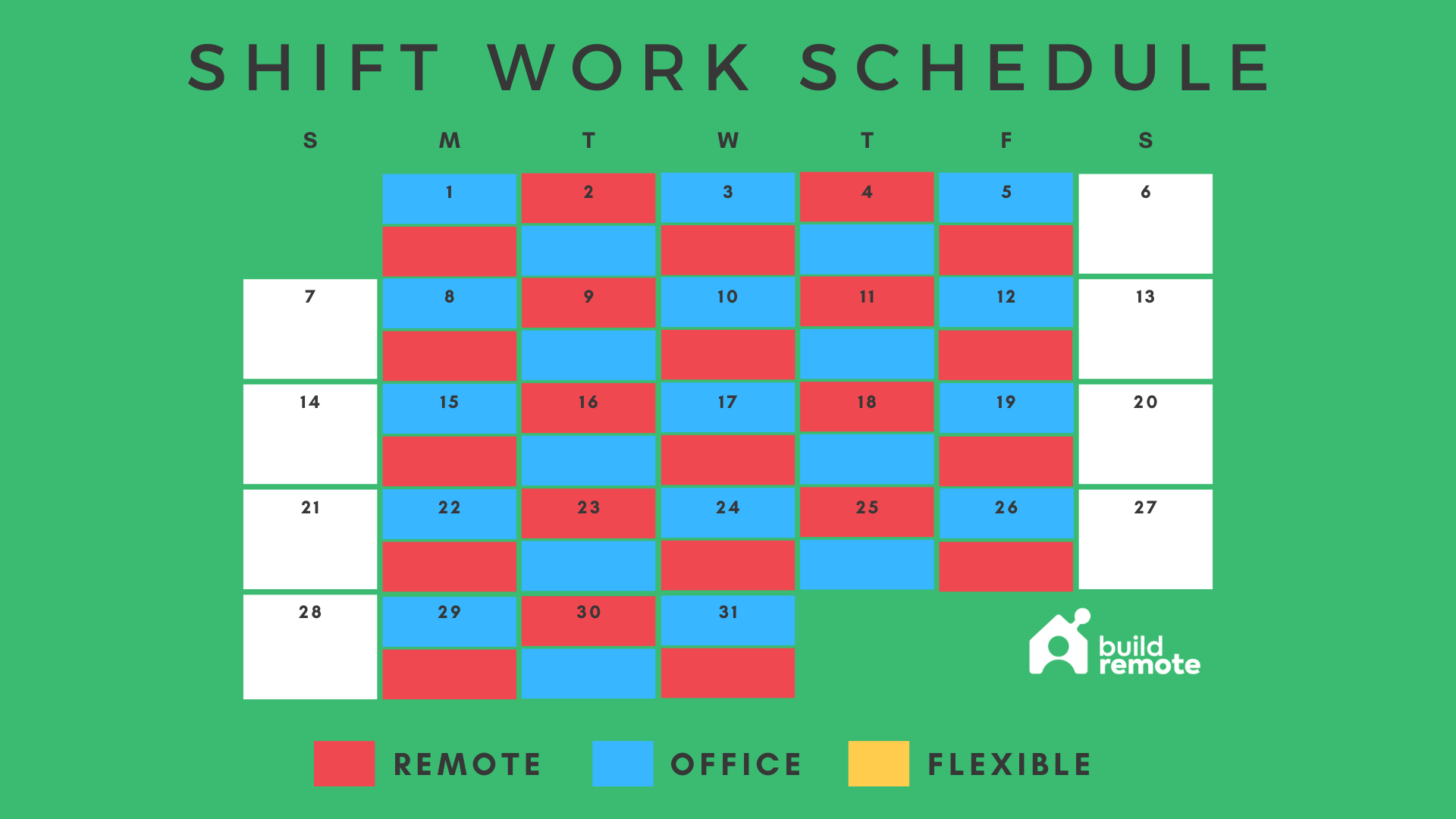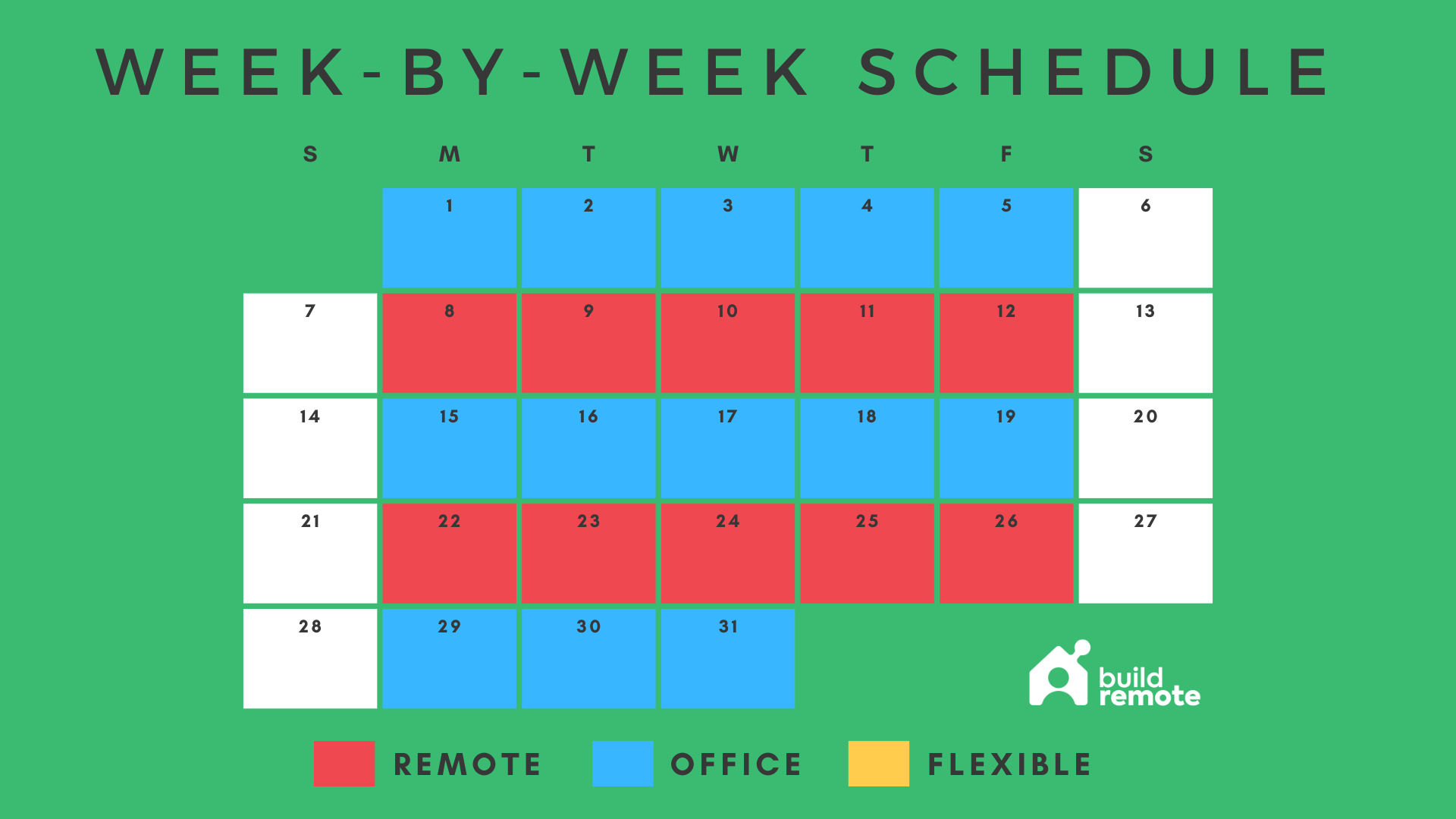15 Hybrid Work Schedules In Use Now [2024]
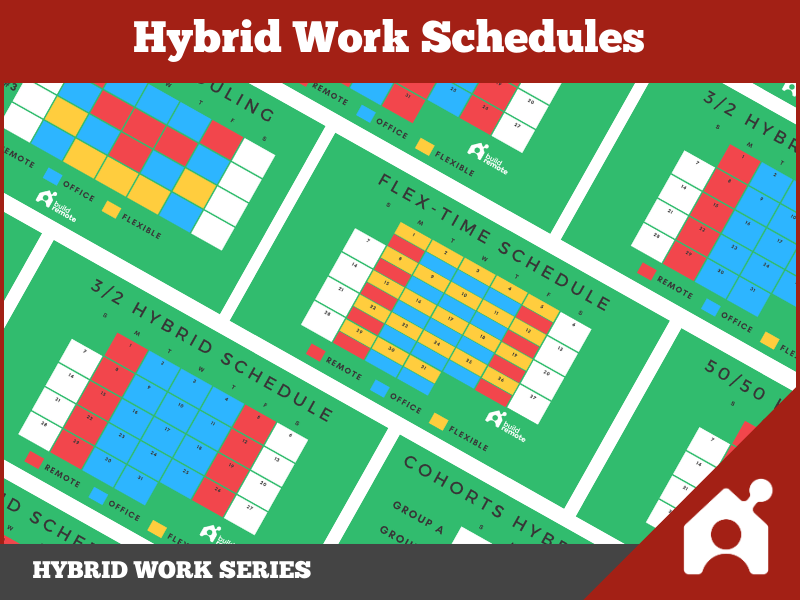
What is a hybrid work schedule?
A policy that states when remote work happens and when office work happens for which employees on which days.
As we’ve been tracking every company switching to a hybrid work model, we’ve found 22 unique names for hybrid work schedules. Companies are making it up on the fly (and making up new names for their hybrid schedules as they go). We consolidated the 22 schedule examples into 15 since a few mean the same thing.
Table Of Contents
- Click the links below to see a breakdown of each hybrid schedule example:
- 2/3 | 3/2 | 50/50 | 90/10 | Bring Your Own | Flex-Time | Cohorts | Manager Scheduling | Office First | Optional | Partial | Remote First | Shift Work | Week-By-Week | Work From Anywhere
- Download all 15 hybrid schedule templates
- Learn how to pick a hybrid policy
- See how popular companies have named their hybrid schedules
2/3 Hybrid Work Schedule
Template downloads: Canva | Excel | Sheets | PDF
- Other names for this schedule: 3/2 hybrid model
- Companies that use this schedule: BP
- Who leads the decision: Executive Team
Employees are expected to come into the office for two days per week and work remotely for three days per week.
This hybrid work schedule calendar could come with set days for everyone to come into the office (like Tuesday and Thursday) or it could be expressed as an expectation for the number of office visits per week.
Pros:
- Close to even mix between remote and in-person
- Less commute for employees
- Consistent expectations for all employees
Cons:
- Schedule is not tailored for certain employees, teams
- Big swings in office attendance on a given day
- Requires more office space than might be needed
3/2 Hybrid Work Schedule
Template downloads: Canva | Excel | Sheets | PDF
- Other names for this schedule: 3/2 hybrid model, 3-2-2 workweek
- Companies that use this schedule: Apple, JPMorgan Chase, Google, Wells Fargo, Lenovo, Nike
- Who leads the decision: Executive Team
Employees are expected to come into the office for three days per week and work remotely for two days per week.
This hybrid policy could come with set days for everyone to come into the office (like Tuesday, Wednesday, and Thursday) or it could be expressed as an expectation for the number of office visits per week.
Pros
- Close to even mix between remote and in-person
- Simpler scheduling, management for team leaders
- Consistent expectations for all employees
Cons
- Schedule is not tailored for certain employees, teams
- Big swings in office attendance on a given day
- Requires more office space than might be needed
50/50 Hybrid Policy
Template downloads: Canva | Excel | Sheets | PDF
- Other names for this schedule: Half & Half
- Companies that use this schedule: Microsoft, Facebook, Uber, Intel
- Who leads the decision: Executive Team
Employees are expected to visit the office for 50% of their work time and work remotely for 50% of their time. This is a policy for office visit expectations rather than a set schedule.
Pros
- Even mix between remote and in-person
- Takes a longer-term view than weekly set schedules
- Consistent expectations for all employees
Cons
- Schedule is not tailored for certain employees, teams
- Lacks consistency for employees (requires changes week-to-week)
- Requires more office space than might be needed
90/10 Hybrid Policy
Template downloads: Canva
- Other names for this schedule: Remote First
- Companies that use this schedule: Dropbox
Coined by Dropbox CEO Drew Houston, this schedule calls for 90% of time spent working remotely with 10% of the time on a few company retreats (or off-sites).
Pros
- Provides a consistent operating system (remote communications)
- Allows for fully remote hiring (expands talent pool)
Less commute for employees - No commute for employees
- Provides in-person benefits through retreats
Cons
- Not everyone wants to travel and this calls for ~25 travel days per year (if the 90/10 rule is accurate)
Bring Your Own Hybrid
Template downloads: Canva | Excel | Sheets | PDF
- Other names for this schedule: Bottom-up model
- Who leads the decision: Manager & Employee
Executive teams come up with choices for hybrid work schedules (like 2/3, 3/2, or 50/50). Then, managers present the options to their teams. Each team decides together which schedule to pursue for their team only, and then team leaders manage expectations to that schedule. This gives employees more autonomy over their schedules but also aligns teams by location and day.
Pros
- Allows for customization by the team
- Gives employees more say in their schedules
- Aligns teams by location and day
Cons
- Does not provide full schedule autonomy to employees
- Could lead to remote work from the office (Zoom meetings in person)
- Could sow dissent from team to team
Flex-Time Hybrid Schedule
Template downloads: Canva | Excel | Sheets | PDF
- Who leads the decision: Employee
Under this model, the executive team typically sets a company-wide policy (like 2/3). Then, employees can set their own work hours within those days. Some may start at 7 AM, others may start around 10 AM. This model is a step closer toward asynchronous work than most hybrid models but still aims to have synchronous blocks of time overlapping for most employees throughout the day.
Pros
- More schedule autonomy for employees
- Allows employees to commute outside of rush hour
Cons
- Inconsistent culture – work days are set, work hours are flexible
- More complex to manage than other options
- Requires more office space than might be needed
Cohorts Hybrid Schedule
Template downloads: Canva | Excel | Sheets | PDF
- Other names for this schedule: Split-week, rotational regional remote
- Companies that use this schedule: ChurnZero
- Who leads the decision: Executive Team
Employees are clustered together into similarly sized groups – cohort A, cohort B, cohort C, etc. The schedule rotates weekly for each cohort’s days in the office and days at home. The idea of the cohort schedule is to rotate in a pattern that has all employees across the company cross paths in the office on a predictable time period (every other week for example).
Pros
- Overlapping in-person time for all employees
- Sets company-wide expectations
Cons
- Overly complex, hard to manage
- Lacks consistency for employees (requires changes week-to-week)
- Gives no schedule autonomy to employees
Manager Scheduling
- Companies that use this schedule: Credit Karma, Amex
- Who leads the decision: Manager
The executive team gives the power to every manager to select a hybrid schedule policy for their teams. This allows for flexibility based on the team.
Pros
- Allows for flexibility team to team
- Allows for the ability to change policies if needed
Cons
- Big swings in office attendance on a given day
- Does not provide full schedule autonomy to employees
- Requires more office space than might be needed
Office First Schedule
- Companies that use this schedule: Goldman Sachs, Morgan Stanley
- Who leads the decision: Executive Team
The processes required to work in an office lead the company’s operations, with remote processes coming second. The company’s policy is to default to office-based interactions. Under this policy, the mix would be heavily tilted toward in-office days (3-5 days per week), meetings would take place in person rather than virtually, and all new hires would come within driving distance of a company office.
Pros
- Consistent policy across the company
- Easier to manage
Cons
- Inconsistent message – allows for remote work but sets it up for failure
- Does not provide full schedule autonomy to employees
- Limits hiring pool geographically
Optional Hybrid Schedule
- Other names for this schedule: Flex, Pick & choose, At-will
- Companies that use this schedule: Amazon, Google, Cisco
- Who leads the decision: Employee
Employees have the option to work from home or the office. Under this policy, employees could be asked to set their preference and stick to it or decide on any given day where to work. This model allows for employee preferences to drive the long-term work model for the company. It will also inform the amount of office space needed company-wide, although it may be hard to manage who sits where on a given day.
Pros
- Allows for flexibility for each employee
- Allows for fully remote hiring (expands talent pool)
Cons
- Hard to manage the amount of office space needed
- This model is essentially fully remote without fully committing to it
Partial Hybrid Work Schedule
Template downloads: Canva | Excel | Sheets | PDF
Some employees, based on role and situation, are able to work from home when they’d like. The policy is determined by role and team rather than across the board. For example, people working in the manufacturing department may be required to come in every day. People in sales might be expected to come in one day per week.
Pros
- Allows for flexibility team to team
- Provides the ability to select a location based on the type of work
Cons
- Does not provide full schedule autonomy to employees
- Could sow dissent from team to team
Remote First
The processes required to work remotely lead the company’s operations, with in-office processes coming second. The company’s policy is to default to remote-based interactions. Under this policy, the mix would be heavily tilted toward remote days (3-5 days per week), meetings would take virtually, and new hires could come from anywhere (not just near the office).
See Also: The Database Of Remote-First Companies
Pros
- Provides a consistent operating system (remote communications)
- Allows for fully remote hiring (expands talent pool)
- Less commute for employees
Cons
- Requires some office space cost (that may not be needed at all)
Shift Work Hybrid Schedule
- Who leads the decision: Executive Team
Under this policy, the people in the office would turn over each day around lunch. One group is working from the office in the morning and then at home in the afternoon, and vice versa. This is not a popular option for companies with knowledge workers. It has been used as a temporary measure for health and safety reasons in education and healthcare much more than offices.
Pros
- Could be used temporarily for specific reasons (health protocols)
Cons
- Overly complex, hard to manage
- Requires daily commutes for employees
- Does not allow for schedule autonomy
Week-By-Week Hybrid
Template downloads: Canva | Excel | Sheets | PDF
- Who leads the decision: Manager
This schedule calls for alternating weeks of remote then in-person and so on.
Pros
- Provides a consistent operating system (remote communications)
- Allows for fully remote hiring (expands talent pool)
- Less commute for employees
Cons
- Does not provide schedule autonomy to employees
- Lacks consistency for employees (requires changes week-to-week)
- Requires full office space cost for 50% utilization
Work From Anywhere
- Companies that use this schedule: Spotify, Shopify
- Who leads the decision: Employee
Employees can choose to work from the office, a coworking space, or home – and can choose to move where they live entirely. Under this policy, the company is remote-first but still has office space available for employees to work from. It’s also likely that the company would provide a stipend for home office equipment or coworking spaces.
Pros
- Provides a consistent operating system (remote communications)
- Allows for fully remote hiring (expands talent pool)
- Provides full schedule autonomy for employees
Cons
- Requires some office space cost (that may not be needed at all)
Learn more about the work-from-anywhere policy.
Download The Hybrid Work Schedule Templates
Every hybrid work schedule/calendar template you read about above is available for you to download, customize, and print or share. We’ve created these templates in four different programs so you can work with the files the way you prefer.
How To Pick A Hybrid Work Schedule Policy
Employee productivity and quality are not derived from the physical location where work takes place. A remote employee could provide $3,000,000 of economic value versus an in-office employee who provides $60,000, or vice versa. The output comes from the employee not the physical location, so I recommend picking a hybrid work setup based on what your employees want. Keep that in mind as you choose the right hybrid work policy for your company:
- Ask managers and employees for their preference on work location (remote first, office first, hybrid, optional, etc.).
- Set the policy that satisfies each individual employee (this would tend to be flexible options, or options selected by individual teams rather than company-wide mandates).
- Avoid sunk cost fallacy. Just because you are committed to a lease for six more years doesn’t mean the office is the right place for your team’s productivity.
- As an executive team, invest time and effort into defining each role’s responsibilities, goals, and measures of success. If you get those right for each team and role, it won’t matter where or when people work… the work will get done (or new team members will be brought on).
Which is the most popular hybrid work schedule?
The most common hybrid policy is three days in the office and two days remote, according to Buildremote’s research on RTO mandates for the Fortune 100.
Companies That Have Named Their Hybrid Schedules
Lots of companies are trying to brand their new way of working internally. Many of the actual policies and schedules they choose fall under one of the 15 you read about above, but with a fancy name put on it. If you want to see what some well-known companies are calling their hybrid schedules, we keep a running list below.
| Company | Schedule Name | Description |
|---|---|---|
| 3M | Work Your Way | Employees work with their managers to determine how often they should be in the office versus remote
Compare to: Manager Scheduling |
| Accenture | Omni-connected | This one is a bunch of corporate jargon and nonsense. In other words, it’s a generic hybrid schedule with lots of promises about changing the future of work, but nothing concrete. Find out for yourself here. |
| Atlassian | Amex Flex | Atlassians choose every single day where they want to work — whether it’s in one of our offices, from home, or a combination of the two.
Compare to: Work From Anywhere |
| American Express | Amex Flex | Each team will pick from one of these three modes – on-site (4-5 days per week), hybrid (1-3 days per week), or fully virtual (0 days expected at the office). Anyone who is hybrid or virtual also has the option to work from anywhere for four calendar weeks per year.
Compare to: Partial Hybrid Schedule |
| Disney | 4-by-1 | Employees are expected to come into the office every Monday – Thursday with the option to work from home on Fridays. |
| General Motors | Work Appropriately | Depending on the nature of their work, employees have the flexibility to work where they can have the greatest impact on results.
Compare to: Partial Hybrid Schedule |
| Intel | Hybrid First | Intel says it plans to become a “hybrid-first” company, allowing most employees to split their time between home and the office.
Compare to: 50/50 Hybrid Schedule |
| KPMG | Flex with Purpose | This policy is full of corporate mumbo-jumbo, too, like Accenture. It focuses on “Diversity, Equity, Inclusion” but doesn’t say anything useful. See for yourself here.
Compare to: Partial Hybrid Schedule |
| Nationwide | Work Anywhere | Nationwide is to allow 13,000 office staff to choose where they work under a new flexibility scheme.
Compare to: Work From Anywhere |
| SAP | Pledge to Flex | SAP pledges to provide a setup that fits every role, style, and location with a 100% flexible and trust-based workplace as the norm, not the exception.
Compare to: Work From Anywhere |
| Spotify | Your Work Mode | My Work Mode allows employees to work full time from home, from the office, or a combination of the two, and gives flexibility when it comes to what country and city each employee works from.
Compare to: Work From Anywhere |
| Stellantis | New Era of Agility | The goal is to have a majority of the company’s salaried employees work remotely most of the time.
Compare to: Remote First |
| TIAA | Work for My Day | The approach gives employees the opportunity to create a hybrid work schedule that is a fluid mix of on-site and virtual work each week.
Compare to: Bring Your Own Hybrid |
| Target | Flex For Your Day | The approach encourages team members to “test and explore when and where they need to be on any given day to do their best work.” Learn more from Target’s leadership.
Compare to: Optional |
Hybrid Work Model: The Complete Overview
|

